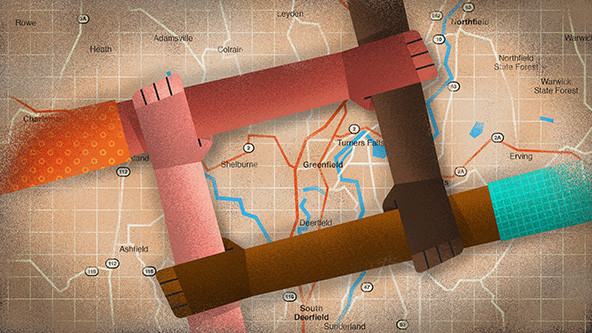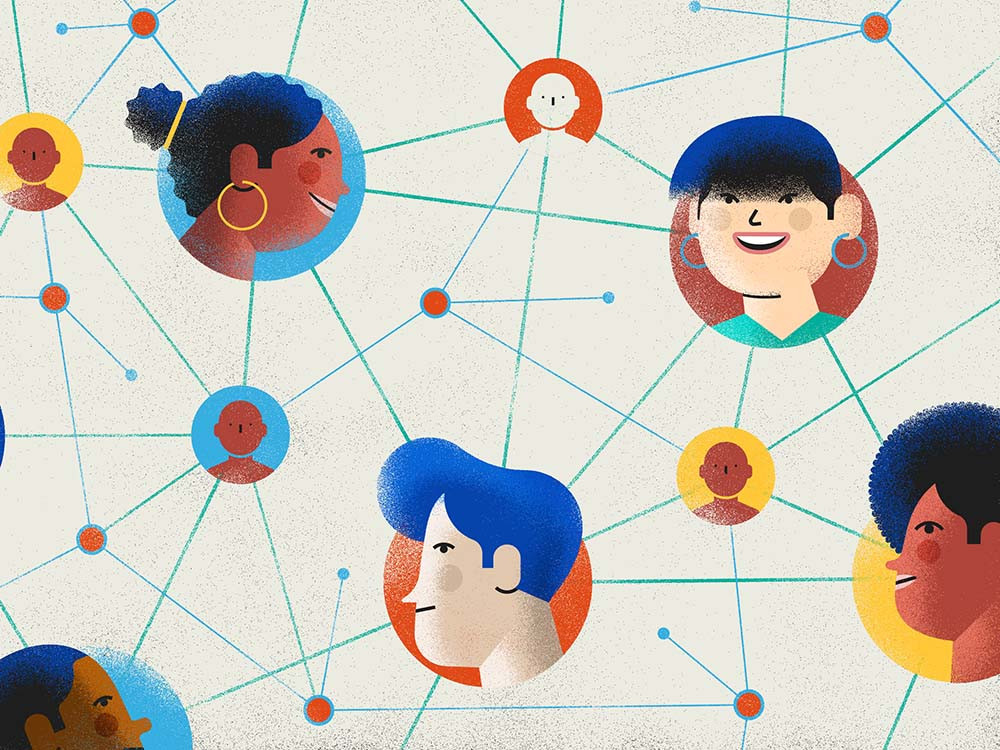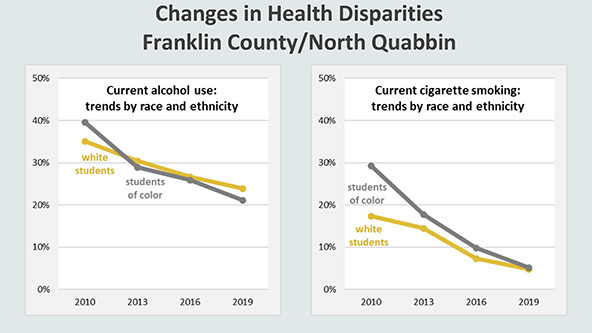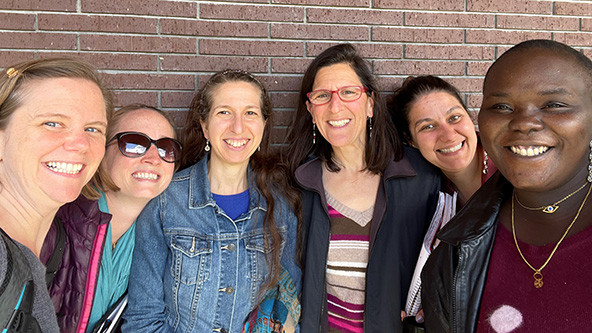 (Illustration by Hugo Herrera)
(Illustration by Hugo Herrera)
In 2012, several organizations—including the Franklin Regional Council of Governments and Community Action Pioneer Valley—came together to address the significantly elevated rates of youth substance use in the region. Together, we formed the Communities That Care Coalition of Franklin County and the North Quabbin (CTC), which aims to improve youth health, well-being, and health equity in the 30 small towns of rural Franklin County and the North Quabbin Region in Western Massachusetts by bringing together key stakeholders, collecting local data, and following national research and best practices.
Soon after we began, FSG’s Fay Hanleybrown, John Kania, and Mark Kramer highlighted our coalition as an early example of collective impact. In their Stanford Social Innovation Review article, “Channeling Change: Making Collective Impact Work,” they noted how our initiative reflected the five conditions that set collective impact apart from other forms of collaboration:
- CTC brought together different sectors to serve the common agenda of improving youth health and reducing youth substance use.
- Our annual teen health survey used a shared system of measurement to help the coalition evaluate and adapt its work.
- We outlined our mutually reinforcing activities through a regularly updated community action plan.
- We ensured continuous communication through work group meetings, email updates, a website, newsletters, and coalition meetings.
- We had strong backbone support from our two host agencies, the Franklin Regional Council of Governments and Community Action Pioneer Valley.

Over time, with these elements in place, we have measured substantial reductions in youth drug and alcohol use, with binge drinking and cigarette use down by more than half since the coalition began, and alcohol and prescription drug misuse down by a third. We have also seen significant reductions in our priority risk factors for youth substance use, including family management problems, parental attitudes favorable to youth drug and alcohol use, and community laws and norms favorable to youth substance use.
Having defined ourselves synonymously with collective impact, we also realized that the constructive feedback and critical conversations about this collaborative approach to social change were likewise relevant to us. In particular, it became clear that we needed to build on the original model of collective impact (and our coalition) so that we could center racial equity as a key necessity in fostering grassroots community ownership and leadership.
Recognizing the Need for Greater Racial Justice
From the beginning, we were a very white, top-down coalition. Though the younger generations in our region were more diverse than the older ones, the population was 91 percent non-Hispanic white. Our coordinating council (our initiative’s governing body) included leaders from traditional seats of power in the community—the police chief, the president of the chamber of commerce, an administrator from the hospital, and a school district curriculum director. And our work groups (the action-oriented groups that choose and implement strategies) were composed almost entirely of middle-class professionals, since we largely recruited people in decision-making roles at local partner agencies. Our parent education work group regularly tried to engage parents with the lived experience of poverty or substance use problems, but was unsuccessful.
From early on we were aware that these were weaknesses in our coalition, but we didn’t quite know what steps to take to address them. Additionally, our outcomes in youth health were exceeding even our most ambitious goals, so we were reluctant to adjust what seemed to be working. But increasingly, we were aware that our vision was myopic, particularly as we worked more closely with the recovery community, whose mantra is “Nothing about us without us!” Ethically, our approach was inequitable and paternalistic if our decision-making table was missing input and leadership from people with lived experience in historically rooted and systematically supported oppression.
Working to Center Racial Justice
In early 2016, we reviewed our initiative’s vision, mission, and values, as we do every three years. One of our coordinating council members suggested the coalition rework its values to focus more on health equity and racial justice, hold regular conversations about both topics, and commit to participating in a racial justice planning retreat. The coordinating council was excited about her proposal, and jumped in with an enthusiasm that surprised many in the group.
A small group of people of color from the coalition helped plan the retreat and hire a facilitator. At the retreat, we brainstormed—and then pursued—the following action steps to center racial justice and equity in our work:
- Focus on racial justice and health equity in our next public release of teen health survey data, drawing community and media attention to local inequities
- Disaggregate the teen health survey data to analyze not just point-in-time differences between groups by race, ethnicity, LGBTQ+ status, and income but also longitudinal changes in these differences
- Hold a racial justice networking and brainstorming dinner with people of color from the community to build relationships and foster conversations
- Form a racial justice work group comprised of people of color from the coalition (and staffed by the backbone agency) who were interested in helping CTC apply a racial justice lens to its work
- Hire a local racial justice consultant to help us with the above action steps as well as others initiatives that would arise
 (Courtesy of Communities That Care Coalition of Franklin County and the North Quabbin)
(Courtesy of Communities That Care Coalition of Franklin County and the North Quabbin)
The racial justice work group had a bumpy start, largely because white staff members from our backbone agency felt that they were not qualified or the appropriate people to lead these initial steps. We hoped our racial justice consultant would take these steps for us, but instead, he implored us to read White Fragility by Robin DiAngelo, which drove home the point that white people caused these problems, and it’s white people’s jobs to work on fixing these problems.
To build stronger relationships within the community we serve and establish our coalition as an organization interested in working on these topics, the racial justice work group has hosted a variety of public events for the community-at-large, including movie screenings on the topics of white privilege and juvenile justice reform, discussions with the chief of police, a COVID-19 town hall, and a meeting with town officials about plans for school redistricting. Coalition staff gave presentations and created a video on race and health equity. The coalition began to co-sponsor racial-justice-focused events put on by our partner organizations and began to build strong connections with other groups addressing racial justice in the community.
At our coalition meetings, we talk explicitly about white privilege, white supremacy, and white-dominant culture. Since our data showed the greatest racial and ethnic disparities in the early initiation of risky behavior, we shifted our priorities to focus more on younger youth and on the early initiation of drugs and alcohol. In 2020, we applied for and received a five-year grant for advancing racial justice in the local public schools, which helped us attract diverse candidate pools and hire two new people of color onto our small staff team.
 Pictured, left to right, are Kat Allen, Amanda Doster, Ilana Gerjuoy, Rachel Stoler, Leigh-Ellen Figueroa, and Keyedrya Jacobs, of the Communities That Care Coalition. (Photo courtesy of CTC)
Pictured, left to right, are Kat Allen, Amanda Doster, Ilana Gerjuoy, Rachel Stoler, Leigh-Ellen Figueroa, and Keyedrya Jacobs, of the Communities That Care Coalition. (Photo courtesy of CTC)
Here are a few of the many lessons we are learning in our journey to center racial justice:
- The will to center racial justice was present in our coalition and community (the need of course was always there).
- Stepping into leading on racial justice is challenging for the white staff and coalition members who are continuously working through the fear of mis-stepping and the feeling that we don’t have the authority to be the ones doing this work. We have had to remind ourselves (and be reminded) that it is everyone’s job to work on undoing racism.
- For the white staff, having partnership with and leadership from people of color has helped build authentic connections within the communities we are serving, as well as programmatic and personal accountability. Staff of color report appreciation for the collaboration, advocacy, and action steps taken by the organization.
- We need to continuously and intentionally work on making the coalition a safe place for people of color to engage. Declaring ourselves allies does not make it so. As a coalition, we need to work on removing barriers (such as unfriendly meeting times and locations) and structures of oppression (such as requiring college degrees for staff positions) and foster leadership pipelines (through opportunities at all levels, trainings, and professional development). The white folks in the coalition need to figure out when to step up and step back, and ultimately, step down from positions of power.
- We have experienced and expect to experience bumps along the way. Staff and members of the racial justice work group have had to work through misunderstandings, hurt feelings, and differing visions: Are we focused on the coalition or the whole community? Are we focused on youth or all ages? How political do we want to be? We remind ourselves that while we know we will continue to fall, it’s important to fall forward. In particular, the white coalition leaders and members have embraced the essential need to set aside our fragilities, our egos, and our defensiveness and learn what we can from the criticisms that will come our way. Humility is our most important tool.
Working to Increase Grassroots Ownership
At the Collective Impact Forum convening in Boston in early 2017, CTC staff were challenged to use a tool called the Spectrum of Public Participation. Created by the International Association for Public Participation, the spectrum aims to help organizations move from informing the community to empowering the community. We asked each of our work groups to write down, under each level of public participation, both what we are doing now to engage community as well as what we’d like to be doing in five years. This process laid out the gap in front of us; our efforts primarily fell on the less involved side of this spectrum, and we wanted to move to the more involved side.
After we created a shared vision for where we wanted to be, we started making changes. We provided a stipend to work group co-chairs in order to recruit leaders who weren’t necessarily working as professionals in the field. This helped mitigate power and access differences between the people who were being paid to be there and those who weren’t.
Our policy and practice change work group recruited a co-chair from the Recover Project, a local organization that works with people in recovery from substance use problems, and moved meetings from the district attorney’s office to the Recover Project’s office attached to their drop-in space, to make them more appealing for people in recovery to participate.
We created a youth leadership board to involve young people not just in CTC’s strategies, but also in leadership and advocacy roles. Youth receive stipends, attend trainings, and participate in the coalition’s coordinating council.
Our parent education work group, now re-named the parent and family engagement work group, moved its meetings from agency offices to public housing complexes, offered incentives for participation, and provided orientation for new members. Eventually this work group developed a grant-funded leadership program to encourage even greater participation from families in the community. Family-serving agencies in the community nominate two to four parents from their programs to participate. Parents are compensated for attending community meetings; sharing their lived experience; reaching out to other parents to share information about community resources; and participating in trainings, workshops, and webinars to learn more about topics like substance use prevention and positive parenting practices. Our original group of parent leaders named the program the Parent Engagement, Enrichment, and Resources (PEER) Ambassador program and worked with a consultant to develop an online, self-directed training program for new ambassadors.
Here are a few things we are learning in our journey to increase grassroots community engagement and ownership:
- Moving along the continuum of community engagement takes time and commitment. It’s hard to jump to shared leadership before collaborating deeply.
- It’s unrealistic and unjust to ask low-income people to come to the table as volunteers when the professionals are being paid to be there. It literally values the opinions of traditionally enfranchised people over others. Offer stipends and paid positions.
- Job descriptions and pay scales may need to be re-tooled when looking for less traditional candidates for jobs. Is a bachelor’s degree really necessary? Is it possible to do the job without owning a car? Can you break down some of these barriers to allow for staff from diverse backgrounds?
- Some people will have trouble accepting stipends for fear of losing certain benefits. Consider whether you can offer gift cards or other incentives as an option.
- The presence of even the nicest staff from housing, child welfare, or law enforcement services may feel very threatening to people who have experienced disempowering, discriminatory, or destructive treatment from these systems.
- When engaging people whose lives are in transition, plan for turnover. Develop good ways to welcome, orient, and maintain communication with new people.
Recognizing Our Shortcomings
We’ve taken steps toward centering racial justice and grassroots community ownership in our collective impact initiative, but we’ve only just begun. We should have stepped up this work long ago, and we credit Black-led, Indigenous-led, and people-of-color-led national movements and local advocacy, with bringing us to where we are now.
CTC is not—and never can be—a coalition that grew up organically out of grassroots organizing. But it is incumbent on us to use the power that we have to change the structures of our coalition and our community to give more power to people who have been unjustly and actively disenfranchised for far too long. We will have blind spots to overcome, and we are committed to learning from our mistakes. Centering racial justice and grassroots engagement in our work will be a long and sometimes difficult process, but it’s urgent and important. We are humbled and inspired by the challenges ahead.
Support SSIR’s coverage of cross-sector solutions to global challenges.
Help us further the reach of innovative ideas. Donate today.
Read more stories by Kat Allen, Rachel Stoler, Keyedrya Jacobs, Ilana Gerjuoy, Sage Shea & Leigh-Ellen Figueroa.

